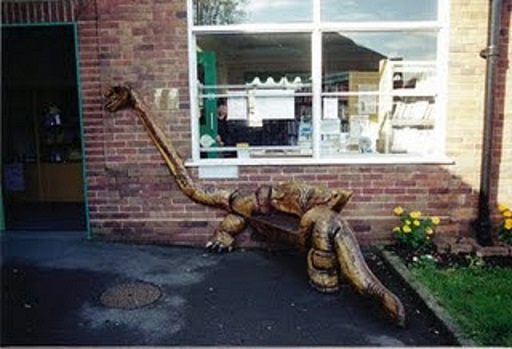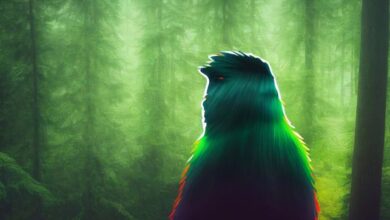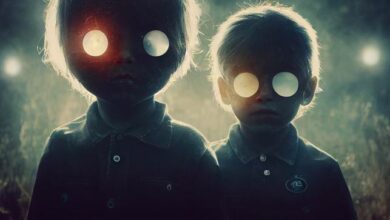Is it Possible That the Loch Ness Monsters Can Stealthily Move from Loch to Other Lochs in Scotland? Tunnels!

Make mention of Scottish lake monsters to most people and it will inevitably conjure up imagery of the Nessies. They are not alone, though: there are other Scottish lochs with monsters in their depths. While many of the accounts are decidedly fragmentary in nature, that is not always the case. Welcome to the world of Morag, the resident beasty of Loch Morar, Scotland, which decided to put on several spectacular displays in 1968 and 1969 – the very time when seriously weird stuff was afoot at Loch Ness and Ted Holiday found his life and research in a whirl. At just over eleven and a half miles in length, Loch Morar has the distinction of being the deepest body of freshwater in the British Isles, with a depth of slightly more than 1,000 feet. Unlike Loch Ness, the water of which is almost black, Loch Morar can boast of having practically clear water. It takes its name from the village of Morar, which is situated close by and specifically at the western side of the loch, and which was the site of the Battle of Morar in 1602 – a violent, death-filled confrontation between the Mackenzie and MacDonell clans.
As for the monster, Morag, the tales are many. What makes them so different to the ones coming out of Loch Ness, however, is not the descriptions of the creatures, but that such reports are often hard to uncover. Unlike Loch Ness, Loch Morar is an isolated, seldom visited loch. It is bereft of much in the way of a large population, and it is not particularly easy to access. The result: tourists to Scotland very rarely visit it. The same goes for native Scots, too! For that reason, just like Las Vegas, what happens at Loch Morar is very often destined to stay there. Nevertheless, there are enough classic cases on record to strongly suggest very strange things lurk in Loch Morar. Folklorist Alexander Carmichael – who, in 1862, penned the book, Popular Tales of the West Highlands – said: “The Morag dwells in Loch Morar. She gives her name to the lake and still appears when any of the old Macdonalds of Morar die. Like the other water deities she is half human half fish. The lower portions of her body is in the form of a grilse and the upper in the form of a small woman of highly developed breasts with long flowing yellow hair falling down her snow white back and breast. She is represented as being fair, beautiful and very timid and never seen save when one of the Morar family dies or when the clan falls in battle.”

That Carmichael termed the Morags as half-human and half-fish, yet others have described them as definitively serpentine, is a good indicator that like the kelpies of Loch Ness, the Morags are shape-shifters. One of the earliest reports came from a man named James McDonald, who claimed a sighting of a three-humped creature snaking through the waters, late one, cold, dark night, in January 1887. Rather ominously, superstitious locals perceived this as a distinctly ill-omen: the three sections were seen as death, a coffin, and a grave – such was the fear that the villagers had of the monster in their midst. Eight years later, Sir Theodore Henry Brinckman, 2nd Baronet, and his wife were fishing at the loch when a long thing, shaped like an upturned boat, surfaced from the depths. One of the locals, a man named MacLaren, dismissed the matter as nothing more than a sighting of the loch’s resident monster. His casual tones suggest he saw nothing strange about a huge beast roaming length, breadth, and depth of Loch Ness. An astonishing sighting occurred in 1948, when a man named Alexander MacDonnell sighted one of the Morags actually on the bank of the shore, at Bracorina Point. In a few moments it practically belly-flopped into the water and vanished. It was a beast described as the size of an elephant. Needless to say, there is no known, indigenous creature in the British Isles that rivals an elephant in size. In the same year, a number of people, led by a Mr. John Gillies, caught sight of an approximately thirty-foot-long animal, displaying no less than four humps.
Then, in August 1968, John MacVarish had a very close view of an unknown animal in Loch Morar, one that displayed a snake-like head of about six-feet in length, and had very dark, or black skin. Without doubt the most amazing – and, for the witnesses, nerve-wracking – encounters occurred on the night of August 16, 1969. That was when William Simpson and Duncan McDonnell were traveling on the waters, near the west end of the loch. Suddenly, as if out of nowhere, a large animal – possibly thirty feet in length – loomed into view and actually collided with their motor-boat. Or, perhaps, rammed it would be a better term to use. When Simpson tried to blast the creature with his shotgun, it sank beneath the waves – as a result of the ear-splitting sound of the gun, both men concluded, rather than as a result of Simpson having actually shot the monster. Mention the words “monsters” and “Scotland” and most people will immediately think of the famous Loch Ness Monster(s) known as Nessie. It’s a far less known fact, however, that unknown creatures have been reported in other Scottish lochs for a very long time. Let’s have a look at Loch Oich. Caley Cruisers note: “Loch Oich is a freshwater loch which forms part of the Caledonian Canal, of which it is the highest point, just over 100 feet above sea level. This narrow loch lies between Loch Ness (to the Northeast) and Loch Lochy (to the Southwest) in the Great Glen. It is fed by the River Garry (from Loch Garry) from the West, and feeds the River Oich from its North end. The Laggan locks separate it from Loch Lochy. A well-marked buoyed channel guides boat traffic safely through Loch Oich. Loch Oich is rich in wildlife with a wide variety of fishes, amphibians, reptiles, birds and mammals.” Let’s see what is known about Loch Oich’s resident “things.”

Nessie authority Roland Watson says: “…the first claimed mention of a creature in Loch Oich is by the famous Dutch cryptozoologist A. C. Oudemans in 1934 when he relates the tale of ‘The Children’s Pool.’ This was a tale of children who saw a creature like a deformed pony appear beside a deep pool of the River Garry which feeds into Loch Oich. The children mounted the docile beast which then flew and plunged into the pool with the children to their doom. The story is believed to be from at least 1894 and though strictly this is perhaps more of a river Kelpie than a loch inhabiting Each Uisge, it is still worth a mention. Peter Costello, who related the Oudemans reference in his book In Search of Lake Monsters felt that Oudemans took the story a bit too seriously and I would agree with him as children riding to their doom was a common motif in the Water Horse genre across various lochs in the old Highlands (as related in the book The Water Horses of Loch Ness). Nevertheless, it does suggest an oral tradition of an Each Uisge in and around Loch Oich before modern times.”
Now, how about we focus our attention on Loch Lochy and its resident beast, Lizzie? Intriguing data can be found at The Official Loch Ness Monster Sightings Register: “Like many other Scottish lochs, Loch Lochy has a history of monster sightings. Located just down the Great Glen from Loch Ness, in many ways it is a better location for monster spotting as there is better access to the shores of the loch. Other than a more recent undated sighting by the proprietors and guests of the Corriegour Lodge hotel within the past 10 years, there has been no real reported activity of late, but this is probably because most people looking for ‘monsters’ drive right past on their way to Loch Ness.” There’s the following, too, which adds notable data to the saga of Lizzie: “In 1960, while staying in a caravan near Glen Fintaig, Eric Robinson, his family, and nine other witnesses, spotted what looked to be a standing wave in the center of the loch. Much to every one’s amazement, Mr. Robinson claimed that the wave was actually a moving creature. Viewing the animal through his binoculars Robinson estimated that the animal was between 30 and 40-feet in length, with a dark spine and a paler underbelly. Robinson and the other witnesses claimed the creature began to roll in the water exposing a huge flipper before disappearing into the loch.”
Roland Watson says: “…the first claimed mention of a creature in Loch Oich is by the famous Dutch cryptozoologist A. C. Oudemans in 1934 when he relates the tale of ‘The Children’s Pool.’ This was a tale of children who saw a creature like a deformed pony appear beside a deep pool of the River Garry which feeds into Loch Oich. The children mounted the docile beast which then flew and plunged into the pool with the children to their doom. The story is believed to be from at least 1894 and though strictly this is perhaps more of a river Kelpie than a loch inhabiting Each Uisge, it is still worth a mention. Peter Costello, who related the Oudemans reference in his book In Search of Lake Monsters felt that Oudemans took the story a bit too seriously and I would agree with him as children riding to their doom was a common motif in the Water Horse genre across various lochs in the old Highlands (as related in the book The Water Horses of Loch Ness). Nevertheless, it does suggest an oral tradition of an Each Uisge in and around Loch Oich before modern times.”
Now, how about we focus our attention on Loch Lochy and its resident beast, Lizzie? Intriguing data can be found at The Official Loch Ness Monster Sightings Register: “Like many other Scottish lochs, Loch Lochy has a history of monster sightings. Located just down the Great Glen from Loch Ness, in many ways it is a better location for monster spotting as there is better access to the shores of the loch. Other than a more recent undated sighting by the proprietors and guests of the Corriegour Lodge hotel within the past 10 years, there has been no real reported activity of late, but this is probably because most people looking for ‘monsters’ drive right past on their way to Loch Ness.” There’s the following, too, which adds notable data to the saga of Lizzie: “In 1960, while staying in a caravan near Glen Fintaig, Eric Robinson, his family, and nine other witnesses, spotted what looked to be a standing wave in the center of the loch. Much to every one’s amazement, Mr. Robinson claimed that the wave was actually a moving creature. Viewing the animal through his binoculars Robinson estimated that the animal was between 30 and 40-feet in length, with a dark spine and a paler underbelly. Robinson and the other witnesses claimed the creature began to roll in the water exposing a huge flipper before disappearing into the loch.”
At just over eleven and a half miles in length, Loch Morar has the distinction of being the deepest body of freshwater in the British Isles, with a depth of just over 1,000 feet. Unlike Loch Ness, the water of which is almost black, Loch Morar can boast of having practically clear water. It takes its name from the village of Morar, which is situated close by and specifically at the western side of the loch, and which was the site of the Battle of Morar – a violent, death-filled confrontation between the Mackenzie and MacDonell clans. A significant number of sightings of unidentified animals have been made at Loch Morar. They have become known as the Morags. One of the earliest reports came from a man named James McDonald, who claimed a sighting of a three-humped creature snaking through the waters, late one, cold, dark night, in January 1887. Rather ominously, superstitious locals perceived this as a distinctly ill-omen: the three sections were seen as death, a coffin, and a grave – such was the fear that the villagers had of the monster in their midst. Eight years later, Sir Theodore Brinckman and his wife were fishing at the loch when a long thing, shaped like an upturned boat, surfaced from the depths. “It’ll just be the monster,” said one of the locals, a man named MacLaren. An astonishing sighting occurred in 1948, when a man named Alexander MacDonnell sighted one of the Morags actually on the bank of the shore, at Bracorina Point. In a few moments it practically belly-flopped back into the water and vanished. It was a beast described as the size of an elephant.
Loch Arkaig has also been a place of interest for those interested in accounts of lake monsters in Scotland. Unknown Explorers say: “Located in Lochaber, Scotland, Loch Arkaig lies 140 feet above sea level, stretches 12 miles in length and has a maximum depth of roughly 300 feet. Loch Arkaig is situated between Loch Ness and Loch Morar and is the reputed home of the Loch Arkaig Monster. Eyewitness descriptions of this creature suggest that it has a long neck, a wide body and four flippers, a description which resembles sightings of the Loch Ness Monster.” What all of this tells us is that if you want to try and see a Scottish lake monster, you don’t have to go to Loch Ness. There are a number of other bodies of water that are home to strange, and even sinister, creatures. Of course, you would think that, by now, the creatures would have been caught. There is, however, the matter of tunnels. Over the years, there have been rumors of tunnels in some of the Scottish lochs. Perhaps, the creatures do go from loch to loch. But, not on the land at night or day. But, by a vast network of tunnels at the bases of the lochs. Imagine that!




